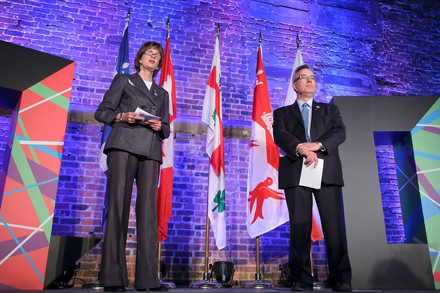
Launch attracts leaders of business, politics, culture and community organizations
By Neale McDevitt
Daniel Lamarre seemed to speak for many of the 400-people gathered for yesterday’s official launch of the ambitious the Quartier de l’innovation (QI) project when he took the microphone and simply said, “Wow!”
As President and CEO of the Cirque de Soleil, Lamarre is no stranger to the concept of wow and he knows that while filling a room is one thing, filling it with excitement is an entirely different challenge. The cavernous hall at the Darling Foundry was not only full of people, it was all but overflowing with a sense of anticipation.
And while the cameras flashed as A-list of dignitaries from the worlds of business, politics and culture greeted each other, the real excitement was generated from the QI itself.
“It didn’t take long to convince me to be a part of the QI,” said Lamarre about his role as one of the project’s ambassadors. “Our dream is to see Montreal [grow] as a creative hub worldwide, and QI will do just that.”
A joint project between McGill and École de technologie supérieure (ÉTS), QI will transform Montreal’s Griffintown neighbourhood into a real living laboratory, where organizations, researchers, citizens, companies and students will work together to enhance the City’s potential for creativity and innovation.
The QI will build on McGill’s strong leadership in basic research and its international network, and on ÉTS’s successful track record in applied research, technology transfer and close relationships with the small- and medium-sized business community in Quebec. The two institutions have signed a formal partnership agreement that spans 25 years and covers many research and teaching projects.
In all, some $6 billion will be invested in QI in the next decade with money coming from both the public and private sectors, with $2.5 million having already been committed to the project.
Principal Heather Munroe-Blum told the audience that while the ambitious QI initiative is not the first of its type in the world, it will take the concept of innovation district to a new level.
“The QI will make Montreal an international leader in innovative cities, building on the experiences of other visionary cities such as Barcelona, Manchester and Boston,” said Munroe-Blum. “Montreal’s Quartier de l’innovation is truly one-of-a-kind as it embraces all aspects of innovation: from the social, cultural and urban dimensions to education, research and industry.”
What makes QI so unique from other urban scientific research parks is that is built on four pillars that project designers have deemed essential to success for innovative societies; industrial, education and research, urban and social and cultural. The extensive network created through the partnership between McGill and ÉTS will promote everything from entrepreneurship and training for the next generation of high-calibre workers to sustainable development of the neighbourhood and the transfer of knowledge to citizens.
Munroe-Blum said the opportunity to partner with ÉTS was too good to pass up for McGill, bringing together “a university that is focused on engineering and on technology applications partners with a university that has all the disciplines and professional faculties and a strong base in basic research to create a real innovation ecosystem… Together McGill and ÉTS cover the full spectrum of innovation from great ideas and basic research right through to applied research and technology transfer.”
For his part Yves Beauchamp, Director General of ÉTS, said the partnership will extend well beyond the walls of the respective universities to have a positive effect on the larger community. “Innovation is essential to ensuring the economic, social and cultural prosperity of our society. The objective of the QI is nothing less than to make Montreal a hub for innovation. ÉTS, located in the heart of the district, will be an active partner in setting up real ecosystem for creativity, forming organic links among our students, our researchers, and the communities.”
Of all the participants, few sounded more enthused than Jean-François Lisée, provincial Minister of International Relations, la Francophonie and External Trade, and Minister responsible for the Montreal region.
“We are much more creative when we combine everyone’s interests and strengths than if everyone is working in silos,” said Lisée. “I’ve come up with an [unofficial] motto for QI: Death to thinking in silos. Long live creative collaboration!”
Lisée said the spirit behind QI is similar to another ambitious initiative undertaken by Montreal that helped put the City on the map internationally. “The underlying feeling at Expo 67 was that everything was possible in Montreal. It was about modernity and invention. It was thinking outside the box,” Lisée told the audience.
“In the coming years we want young people who are looking to create and innovate – be they in Singapore, Shanghai, San Francisco or Berlin – to say ‘What they are doing in Montreal is extraordinary. All the innovations that are coming from there – in life sciences, in engineering, in video games, in culture, in circus arts, etc. – I want to be there because that’s where it is happening.’
“We want people to say, ‘What will come out of Montreal this year?’”
For more information on QI, click here.
